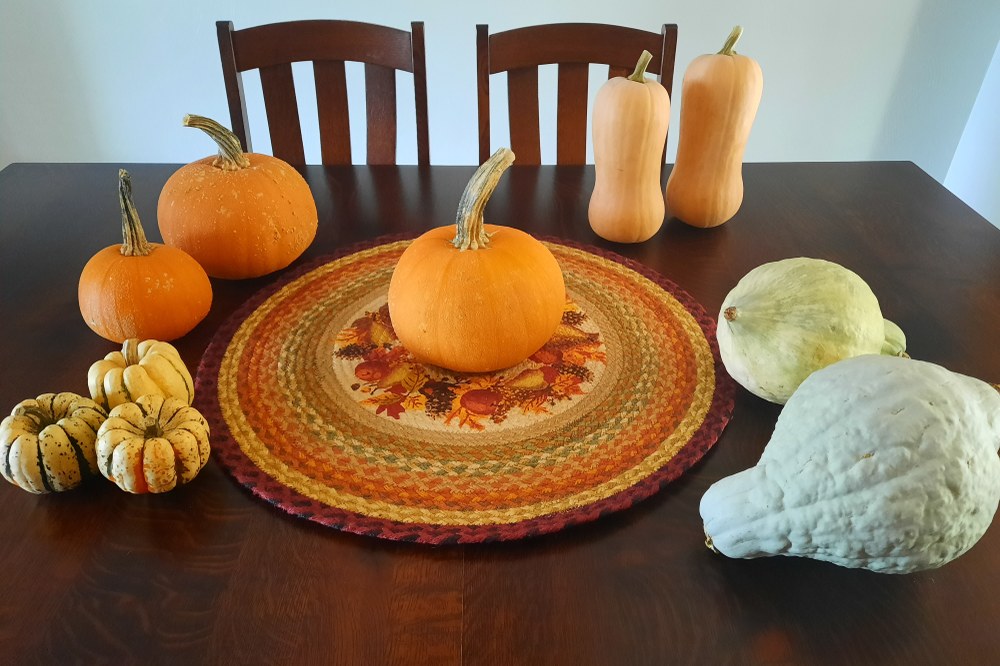Learn about the many varieties of squash

Photo credit: Glen Bupp
By the time October rolls around, most of us have noticed any number of round orange things, green and orange things, yellow things - some with funky long necks, some with lumpy green bumps. They're all attached to lanky, big-leafed vines, and then placed on our porches, front steps or garden beds as decorations. Of course, I am talking about pumpkins, squash and gourds. Those iconic autumn "things." Probably we think of pumpkins as pie or jack o'lanterns; squash as hundreds of ways to stuff or make a casserole, and gourds…well, you dry them and scoop them out to make them into birdhouses, right?
I have often wondered what makes each of these autumn "things" distinctly its own "thing" - species, genus, whatever. Maybe you have, too. So I hope to take some mystery out of what makes them what they are.
It turns out that pumpkins, squash and gourds are all in the family Cucurbitacae which includes a mind-boggling 100+ genera and over 700 individual species. That's a LOT of squash! And, pumpkins, squash, and gourds are autumn fruits - yes, not vegetables - and are all harvested at the same time of year. They are ALL essentially SQUASH, and botanically, they are the same. But different.
Hmmmm…not sure, this is clearing up my questions.
Generally, in the US, we refer to any large-ish, round, orange thing on a vine as a pumpkin. But "pumpkin" is more or less a made-up name for this cultivar, this type, of winter squash. The distinction between what we call pumpkins, squashes and gourds is getting a tad murkier.
And, pumpkins can range from that bright orange color to tan, yellow, blue or grey. They can be green. They can be smooth-skinned, striped, or pocked with green or grey lumps or scabs - which I learned are actually pockets of sugars under the fruit's skin. And, they are notorious for cross-breeding, creating new and scary versions of themselves - freaky-looking even before the carving of jack o'lanterns begins! But, generally, what we call a pumpkin is a squash best known for Halloween décor and pies.
Of course, here in South Central Pennsylvania, most bakers I know swear by crookneck squash, not pumpkin, for their holiday pies. Yet more confusion, and perhaps a topic for another article.
What we typically refer to as a "squash" in the market or grocery store, may be two separate things: summer squash - thin-skinned and easily prepared for a meal, as in zucchini or patty pan; OR winter squash - hard-skinned, botanically ideal for storing in the cellar over long, cold months, and generally requiring peeling or scooping to be eaten. Hubbards, spaghetti squash, and butternuts come to mind. Delicious to eat but silly to consider carved like a jack o'lantern. Hard on the teeth, too, unless peeled in some way. But mainly a culinary fruit of summer and autumn.
Gourds are also technically squash but are defined by the Missouri Botanical Garden site as "hard-shelled durable fruit grown principally for ornament, utensils and general interest." Generally not eaten, by humans anyway. Varieties include speckled swan gourds, dipper gourds, and bottle gourds. Gourds are often dried, scooped, and carved into containers, as well as the favored birdhouses that hang in my own backyard. Gourds are purely decorative…except that some, when immature, may be eaten like squash. Oh my…what ?
So, in the end, all SQUASH - or pumpkins or gourds - are the same thing and many different things. It just depends on what you need a squash to be at the time. Something to decorate with for Halloween and Thanksgiving…something for a delicious, nutritious meal… something to house a sparrow.
As for me, I am heading to the Pumpkin Patch, and hope to keep it simple: Gettin' me a pumpkin to carve and light with a candle to greet the lovely Autumn night. Right after a yummy dinner of stuffed butternut squash and a quick check on my nesting sparrows in their carved gourd.
Written by Karen Knuepfer, York County Master Gardener

